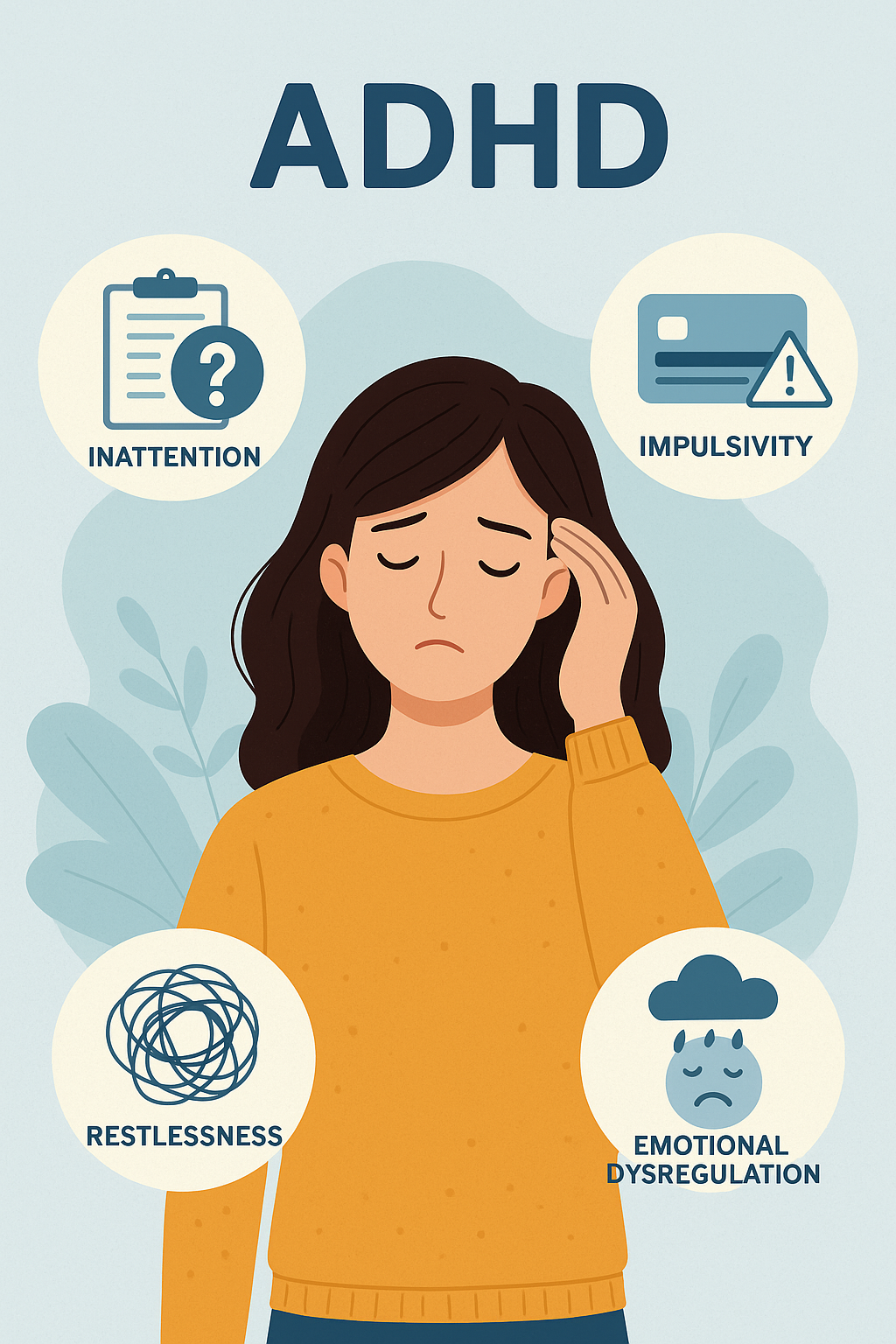ADHD isn’t always obvious.
Sometimes it looks like someone who never stops moving. Other times, it’s a woman quietly overwhelmed: late to appointments, constantly second-guessing, or exhausted from masking the chaos no one else sees.
That’s the version many people miss.
For years, ADHD has been misunderstood as something that mostly affects young boys. That image still lingers in the public eye. But ADHD in women doesn’t usually play by those rules. It tends to stay quiet. It blends into anxiety or stress or a life filled with to-do lists that never get shorter.
And because of that, a lot of women go undiagnosed.
The Quiet Side of ADHD
ADHD has three main presentations: inattentive, hyperactive-impulsive, and combined. Most women with ADHD fall into the inattentive category. Instead of outward disruption, they wrestle with internal chaos that includes losing keys, zoning out mid-conversation, and missing deadlines despite trying their best.
The problem is that inattentive symptoms don’t demand attention the way hyperactivity does. A boy who can’t sit still draws concern. A girl who quietly stares out the window is simply seen as dreamy or shy. This mismatch in visibility is one major reason ADHD in women goes unrecognized.
It doesn’t stop in childhood. A 2020 expert consensus confirmed that girls are far less likely to be referred for ADHD testing unless their symptoms are extreme. Many learn early on to compensate by over-preparing, people-pleasing, and hiding the struggle, which only makes them harder to identify later.
Masking, Mislabeling, and High-Functioning Anxiety
Most women with ADHD don’t “look like” the stereotype. They build systems to keep up, work overtime to appear organized, and anticipate rejection and try to avoid it by saying yes to everything.
This is called masking, a set of social and mental gymnastics that women use to pass as neurotypical. It often leads to something that looks like high-functioning anxiety. They meet deadlines, but barely. They remember the appointments but panic the night before. They manage life but only just, and no one sees the cost.
According to a 2023 review, many women with ADHD report feeling “lazy” or “broken” long before diagnosis. They internalize failure, chalking it up to personal flaws rather than a neurological condition. For them, a diagnosis is often less a label than a relief: finally, an explanation.
What Symptoms Look Like in Real Life
To be clear, women do show classic adult ADHD symptoms. However, they tend to present differently from men. Here’s how that plays out:
- Inattention: Looks like missed deadlines, unread emails, forgotten groceries, or zoning out during meetings.
- Hyperactivity: Often shows up as internal restlessness rather than fidgeting. Thoughts race. Sleep suffers.
- Impulsivity: Can mean blurting in conversations, overcommitting to projects, or making emotional purchases.
- Emotional dysregulation: Mood swings, irritability, or feeling overwhelmed by minor stressors.
Other common indicators include:
- Messy living spaces
- Difficulty sustaining friendships
- Low self-esteem
- Disordered eating patterns
Many of these symptoms overlap with depression or anxiety, which is why misdiagnosis is so common.
The Role of Hormones and Life Transitions
Another layer that often goes overlooked is hormones.
Women with ADHD frequently report worsening symptoms during hormonal shifts, including during puberty, PMS, pregnancy, and perimenopause. Estrogen affects dopamine, a key neurotransmitter in ADHD, which explains the rollercoaster.
Julia Edwards, an ADHD specialist and licensed counselor, notes that many women don’t realize they have ADHD until their 30s or 40s, when hormonal changes unmask long-managed symptoms. She has observed that 90% of her adult ADHD clients are women, often diagnosed later in life.
The Cost of a Missed Diagnosis
The impact of unrecognized ADHD is heavy. Without proper care, many women face the following long-term challenges:
- Academic underperformance despite high potential
- Career instability from missed details or chronic overwhelm
- Relationship strains due to forgetfulness, mood swings, or impulsivity
- Mental health issues, including anxiety, depression, and even trauma
A 2018 CDC study found that ADHD medication prescriptions for women ages 15–44 increased by 344% between 2003 and 2015. That’s a sign that more women are finally getting the help they’ve needed for years.
Still, diagnosis is just the first step. Treatment must reflect the full complexity of their lives.
What Effective ADHD Treatment Looks Like for Women
The best ADHD care understands the person behind them. At Zeam Health & Wellness, we take that commitment seriously. Our ADHD treatment in Sacramento, Folsom, and Roseville centers on comprehensive, adult-specific support.
Here’s what that looks like:
Comprehensive Evaluation
We don’t rush diagnosis. Our initial 60-minute consultation allows time to explore your full experience, followed by QB Check, an advanced digital tool for measuring attention and activity patterns. For adults with layered symptoms, this level of precision makes a difference.
Personalized Treatment Plans
No two women experience ADHD the same way. That’s why we customize every plan. Whether you need stimulant or non-stimulant medication, therapy, or both, we tailor it to your work life, relationships, and goals.
We also offer genetic testing, which helps predict how you’ll respond to specific medications, especially if anxiety is also in the picture.
Therapy Options That Go Deeper
ADHD rarely travels alone. Many women carry trauma, burnout, or emotional fatigue. Our therapy team integrates:
- Cognitive Behavioral Therapy (CBT) to reframe negative thought patterns
- EMDR for trauma that amplifies ADHD challenges
- Neurofeedback to retrain the brain for better focus and regulation
We also provide flexible online sessions, so care fits into your schedule.
A Final Word for Women Who Are Still Wondering
If any part of this post sounds familiar, you’re not alone. Many women spend years trying to explain what feels “off.” They push harder, blame themselves, and wait for things to get easier. However, ADHD doesn’t fade with time. It morphs.
Diagnosis is key, and the right treatment is the doorway to a different kind of life.
If you’re ready to explore that possibility, we’re here to help. At Zeam Health & Wellness, we listen, adapt, and walk beside you through the process.
You deserve more than just getting by. With the right support, you can build a life that actually fits you.
Contact us to explore individualized ADHD treatment in Sacramento, Folsom, or Roseville with Zeam.




